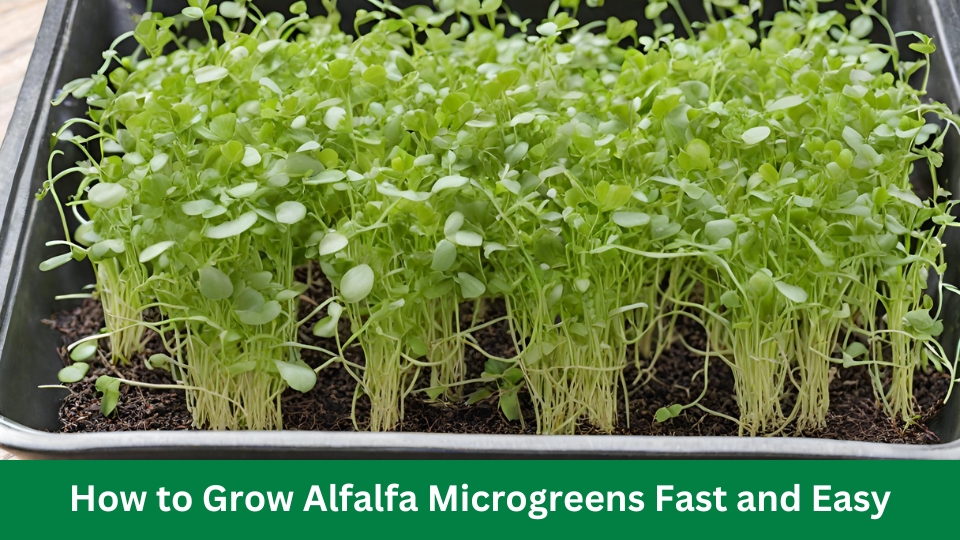To grow alfalfa microgreens, follow these steps for optimal growth and yield. First, soak the seeds overnight, then spread them evenly on a tray filled with potting soil.
Next, cover the tray with a damp cloth and allow the seeds to germinate for two days. After that, remove the cloth and place the tray in a well-lit area. Water the microgreens regularly, keeping the soil moist but not waterlogged.
Within 7 to 10 days, the microgreens will reach their maturity stage, and you can harvest them by cutting just above the soil level. Rinse the harvested microgreens, which are now ready to be enjoyed in salads, sandwiches, or smoothies.
Benefits Of Growing Alfalfa Microgreens
Growing Alfalfa microgreens is a rewarding and beneficial practice that can be easily incorporated into your daily routine. These tiny, tender sprouts contain essential nutrients and offer various health benefits. Whether you are a health enthusiast or simply someone looking to add freshness to your meals, alfalfa microgreens are an excellent choice.
This article will explore the nutritional and health benefits of growing alfalfa microgreens and their advantages for your hair and teeth.
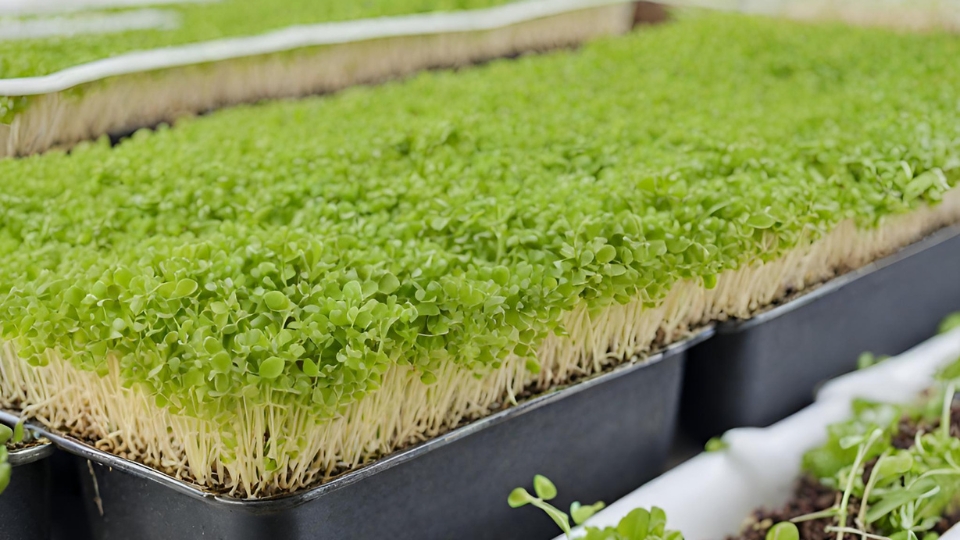
Nutritional Benefits
Alfalfa microgreens are a powerhouse of nutrients, providing your body with abundant essential vitamins and minerals. These sprouts are particularly rich in vitamin K, which plays a key role in blood clotting and bone health. Additionally, alfalfa microgreens are an excellent source of vitamin C, which supports a healthy immune system and aids in collagen production for skin health.
The high levels of vitamin A found in alfalfa microgreens contribute to maintaining healthy vision and supporting a healthy immune system. These sprouts also contain vital minerals such as calcium, iron, and magnesium, essential for strong bones, maintaining proper muscle function, and promoting healthy red blood cell production.
Health Benefits
Consuming alfalfa microgreens can have a positive impact on your overall health. These sprouts possess anti-inflammatory properties, which can help alleviate the symptoms associated with inflammatory conditions such as arthritis. Additionally, alfalfa microgreens are believed to possess antioxidant properties that protect cells from damage caused by harmful free radicals.
Research has also suggested that alfalfa microgreens may have cholesterol-lowering effects, which can contribute to cardiovascular health. Regularly consuming these sprouts may help maintain healthy cholesterol levels, reducing heart disease risk.
Alfalfa Benefits For Hair
Alfalfa microgreens also benefit hair health. The nutrients present in these sprouts, such as vitamin A and vitamin C, promote healthy hair growth.
The vitamins, iron, and protein content strengthen hair follicles, prevent breakage, and enhance overall hair texture. Including alfalfa microgreens in your diet can make your hair more lustrous, shiny, and voluminous.
Alfalfa Benefits For Teeth
In addition to the numerous other benefits, alfalfa microgreens also play a role in maintaining oral health. Sprouts contain essential minerals like calcium and magnesium, strengthening tooth enamel and maintaining strong and healthy teeth. Regularly consuming these sprouts may prevent dental cavities and gum diseases, ensuring healthy oral hygiene.
Incorporating alfalfa microgreens into your diet adds fresh flavor to your meals and offers various nutritional benefits for overall health, skin, hair, and teeth. Whether you grow them at home or purchase them from a local supplier, alfalfa microgreens are an excellent addition to any healthy lifestyle.
Preparing The Growing Container
Growing alfalfa microgreens at home is an excellent way to add freshness and nutrition to your meals. Preparing a growing container properly is crucial to ensure successful growth. This section will guide you through the essential steps of selecting a container, preparing the soil, and setting you up for a bountiful harvest.
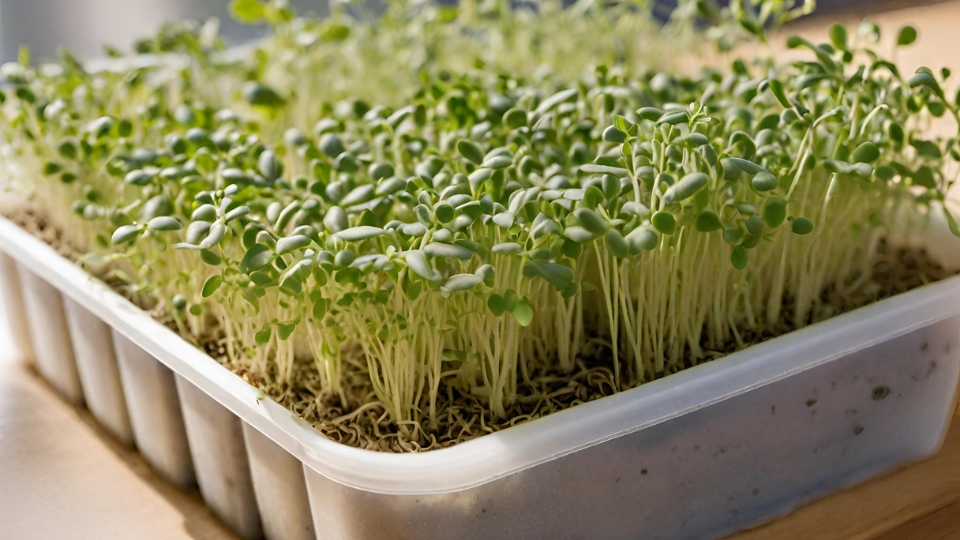
Selecting A Container
Choosing the right container for your Alfalfa microgreens is key to their healthy development. Look for a shallow tray or dish with drainage holes to prevent waterlogged roots. Suitable options include plastic or terracotta, seedling trays, or even repurposed shallow containers like old baking sheets or trays. The container should be clean and free of contaminants that could harm the delicate microgreens.
Preparing The Soil
The soil you use to grow alfalfa microgreens is crucial to their growth and development. Here are the steps to follow when preparing the soil:
- Gather the necessary materials: To create a nutrient-rich growing medium, gather high-quality potting soil or mix, organic compost, and vermiculite or perlite.
- Choose organic soil: Opt for organic potting soil or mix free from synthetic fertilizers or harmful chemicals. This will ensure that your microgreens grow in a healthy and natural environment.
- Add compost: Incorporate organic compost into the potting soil to enhance fertility and provide essential nutrients to the growing plants.
- Add vermiculite or perlite: Mix in vermiculite or perlite to improve soil drainage and prevent it from becoming overly compacted. These lightweight additives also aid in retaining moisture, which is crucial for the growth of microgreens.
- Moisten the soil: Before filling the growing container with soil, ensure it is moist. This will facilitate seed germination and root development.
These steps will create an optimal growing environment for your alfalfa microgreens, setting them up for success.
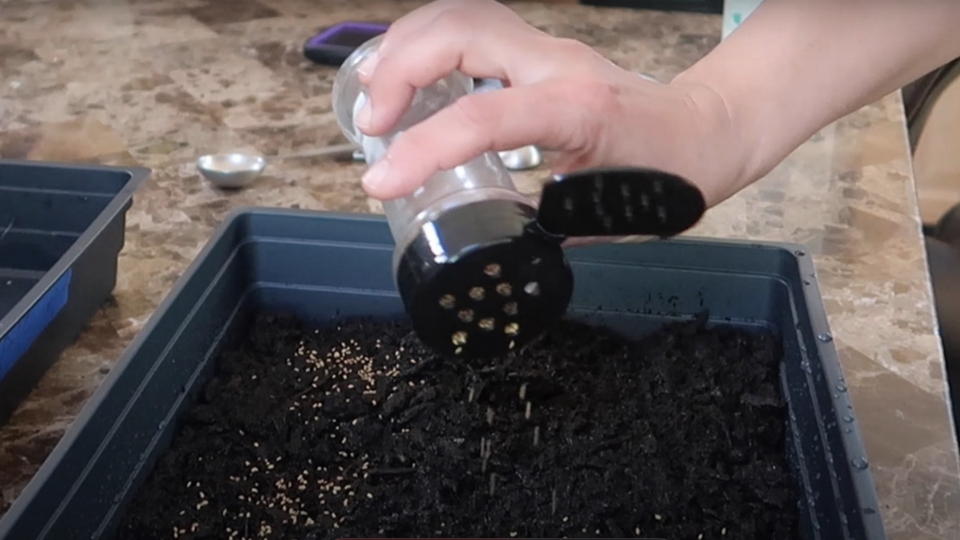
Remember to keep the soil consistently moist throughout the growth process without allowing it to become waterlogged.
Providing The Optimal Growing Conditions
Alfalfa microgreens thrive best under optimal growing conditions, ensuring harvest success. Create the proper environment with proper temperature, light exposure, watering, and quality soil for healthy and flavorful microgreens.
Temperature
Providing the optimal temperature range is crucial to ensure the successful growth of alfalfa microgreens. These tiny plants thrive at temperatures between 60 and 75 degrees Fahrenheit (15 to 24 degrees Celsius). Maintaining a consistent temperature within this range throughout the growth cycle is essential for healthy and vigorous microgreen development.
Lighting
Lighting is crucial to alfalfa microgreen growth as it fuels their photosynthesis process. Place the trays or containers in a well-lit area, preferably near a south-facing window where they can receive ample sunlight. Consider using grow lights to provide adequate illumination if natural sunlight is insufficient.
Position the lights approximately 6 inches above the trays, keeping them on for around 12-16 hours daily, ensuring consistent and uniform light distribution.
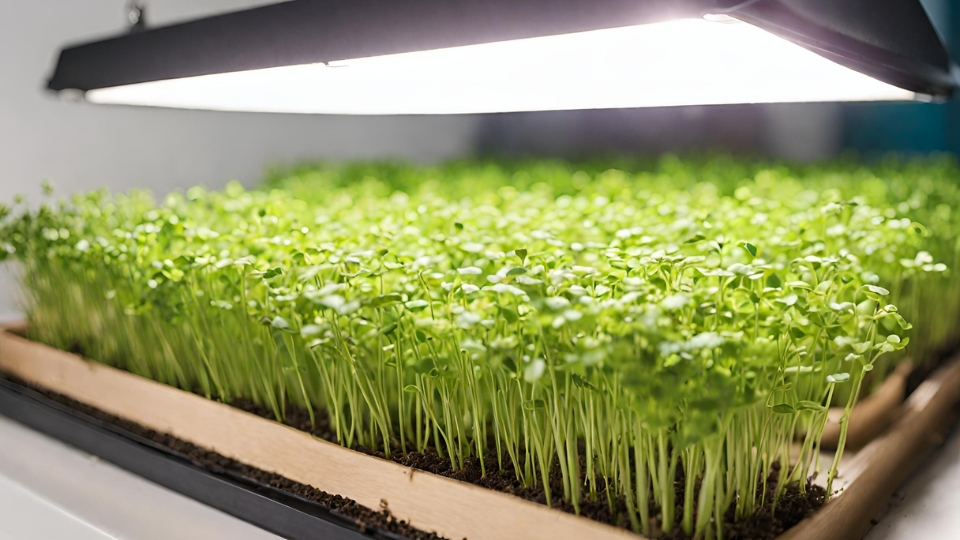
Humidity
Humidity levels significantly impact alfalfa microgreen growth and quality. Aim for a humidity range of around 40-60% during the germination phase and slightly lower, around 30-40%, during subsequent growth stages. To maintain the desired humidity, you can utilize a hygrometer, which measures humidity. You can adjust accordingly using a humidifier or dehumidifier if necessary.
Watering And Feeding The Microgreens
Proper watering and feeding are crucial for alfalfa microgreen success. These tiny plants require consistent moisture and nutrients to grow healthily and reach their full potential.
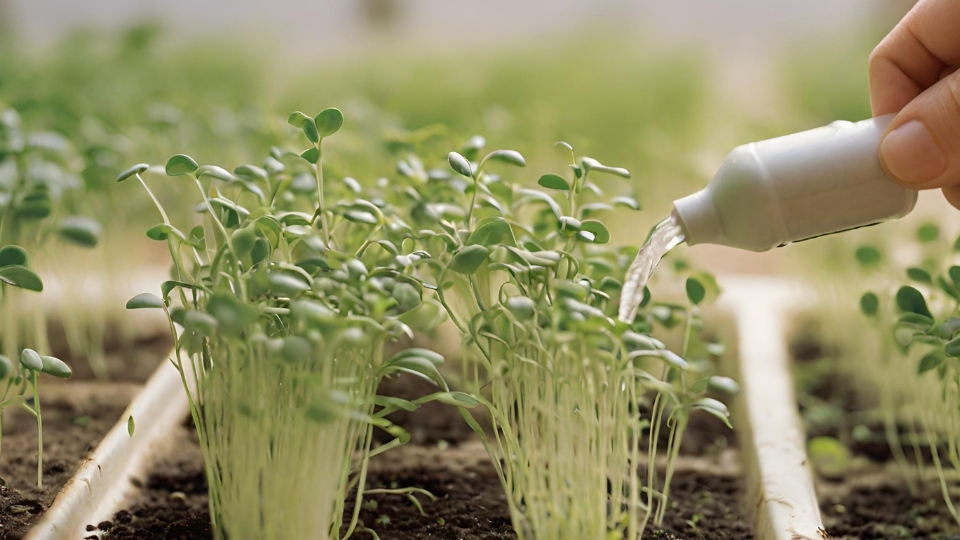
This section will discuss the recommended watering schedule and fertilizing techniques to ensure your microgreens thrive.
Watering Schedule
Establishing a well-defined watering schedule is essential to prevent under or overwatering your alfalfa microgreens. Here’s a suggested watering schedule to keep your plants happy and hydrated:
- Day 1: After sowing the seeds, thoroughly water the planting tray or container using a spray bottle or a fine-mist sprayer. Make sure the top layer of soil is evenly moist.
- Day 2-3: Check the moisture level of the soil. If the top layer feels dry, water gently using the sprayer. Avoid waterlogging the soil, as it can lead to root rot.
- Day 4-6: Continue monitoring the moisture level and water as needed. Microgreens typically require watering every 1-2 days, depending on the weather conditions and humidity.
- Day 7: It’s time to harvest your alfalfa microgreens! Before harvesting, water lightly to facilitate easier harvesting.
Fertilizing
Fertilizing your alfalfa microgreens provides vital nutrients to support healthy growth and enhance their nutrient density. Here are a few fertilizing tips to help you nourish your microgreens:
- Organic Fertilizers: Consider using organic fertilizers such as compost, worm castings, or seaweed-based products to ensure a natural and chemical-free growing environment.
- Dilute the Fertilizer: When applying fertilizers, dilute them to half the recommended strength to prevent nutrient burn or overpowering the plants with excessive nutrients.
- Apply Fertilizer Sparingly: Microgreens have a short growing period, so it’s important to apply fertilizers sparingly to avoid overfeeding. Start with a weak solution and gradually increase if necessary.
- Feeding Frequency: Apply fertilizers every 5-7 days, but do not overdo it. Microgreens are sensitive to nutrient imbalances, so it’s better to go lighter on the fertilizer.
Proper watering and feeding are key to growing vibrant and nutritious alfalfa microgreens. Be mindful of moisture levels and provide them with the right amount of organic fertilizer for optimal results. Now that you know the watering and feeding techniques, it’s time to put them into practice and watch your microgreens flourish!
Harvesting And Storing Alfalfa Microgreens
Growing alfalfa microgreens is an excellent way to add a nutritious and flavorful ingredient to your meals. But once your microgreens have reached their optimal growth stage, it’s time to harvest and store them properly to preserve their freshness and flavor. This section explores two key steps: proper storage and harvesting at the right time.
Harvesting At The Right Time
Harvesting your alfalfa microgreens at the right time is crucial to ensure they have developed the maximum nutrition and flavor. Generally, waiting until the first true leaves appear is best, usually around 10 to 14 days after sowing.
When harvesting, use a sharp pair of scissors or a clean knife to cut the microgreens just above the soil level. Take care not to damage the roots or disturb the soil too much. Remember, the key is to harvest microgreens when they are freshest and most nutritious.
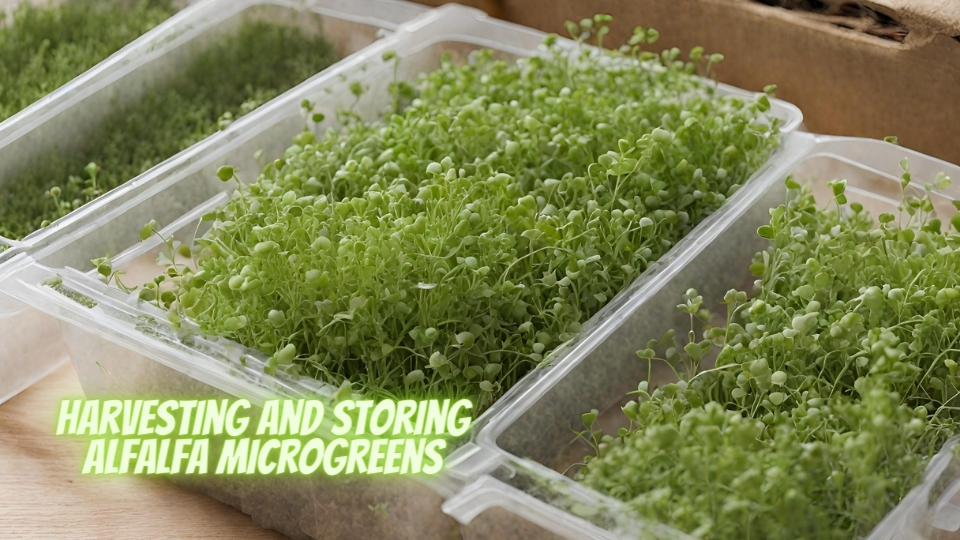
Harvesting The Microgreens
Once you’ve determined that your alfalfa microgreens are ready to be harvested, follow these steps for a successful harvest:
- Gather your supplies: Prepare a clean pair of scissors or sharp knives, a clean tray or container to collect the harvested microgreens, and a small brush or cloth to remove debris.
- Cut the microgreens: Hold them gently with one hand while cutting them just above the soil level using scissors or a knife. Avoid cutting too close to the soil to prevent contamination.
- Collect the harvested microgreens: Place them carefully into the clean tray or container, ensuring that they don’t overlap or get crushed.
- Clean and remove debris: Use a small brush or cloth to remove any soil, debris, or roots from the harvested microgreens. This step helps improve their appearance and extends their storage life.
Determining The Right Time To Harvest
The timing of your harvest plays a vital role in your alfalfa microgreens’ taste, texture, and nutritional value. It would be best to wait until the microgreens have grown to a specific stage before harvesting. Here are some key indicators to determine the right time:
- Height: Alfalfa microgreens should reach a height of about 2-3 inches when they are ready to be harvested.
- Leaf development: The microgreens should have developed their first true leaves in addition to the cotyledons (seed leaves).
- Coloration: Look for vibrant green leaves. Yellowing or browning leaves indicate that the microgreens are past their prime.
- Taste test: If you’re unsure whether they’re ready, pluck a small leaf and taste it. The flavor should be mild and slightly nutty.
Proper Storage
Once you have harvested your alfalfa microgreens, storing them properly is important to maintain their quality and freshness. Here are some tips to ensure proper storage:
- Clean and Dry: Before storing, gently brush off any dirt or debris from the microgreens. Ensure they are completely dry to prevent moisture buildup, which can lead to spoiling.
- Refrigerate: Place the harvested microgreens in a breathable container or a ziplock bag and store them in the refrigerator. The ideal temperature for storage is around 35 to 40 degrees Fahrenheit.
- Use within a Week: To enjoy the best flavor and nutrition, consuming the microgreens within a week of harvesting is recommended. As time goes on, their freshness and nutritional value begin to decline.
Following these harvesting and storage practices ensures that your alfalfa microgreens stay fresh and flavorful for as long as possible.
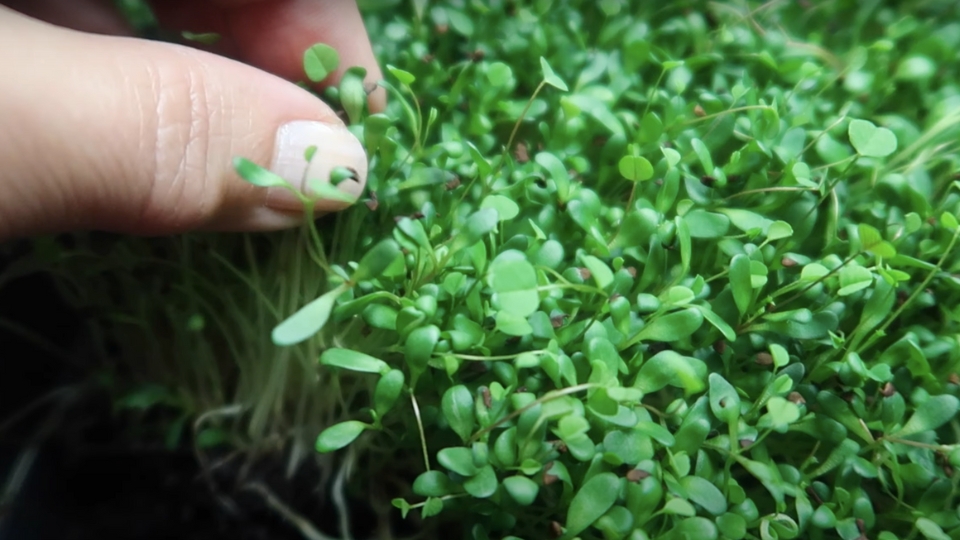
Troubleshooting Common Issues
Learn how to troubleshoot common issues when growing alfalfa microgreens. Discover tips and tricks to ensure successful growth and a bountiful harvest.
Pests and Diseases
Pests and diseases can significantly threaten the health and growth of your alfalfa microgreens. Taking proactive steps to prevent and manage these issues is crucial. Here are some common pests and diseases you may encounter:
| Pest/Disease | Symptoms | Treatment |
|---|---|---|
| Aphids | Sucking pests that cause yellowing and distortion of leaves. | – Spray neem oil solution on affected plants – Introduce beneficial insects like ladybugs to control aphid population |
| Fungal diseases (e.g., damping-off) | Drooping stems, wilting, and moldy appearance. | – Provide good air circulation and ventilation – Avoid overwatering to prevent excess moisture |
| Mildews | White powdery growth on leaves. | – Spray a solution of 1 part milk to 9 parts water – Remove affected leaves promptly |
| Root rot | Stunted growth, yellowing, and wilting. | – Ensure proper drainage to prevent waterlogged soil – Use well-draining soil mix and avoid overwatering |
Overwatering Or Underwatering
Proper watering is essential for the successful growth of alfalfa microgreens. Both overwatering and underwatering can lead to poor growth and even plant death. Here’s how to tackle these problems:
- Overwatering: When soil is constantly soggy, it deprives the plants of necessary oxygen, leading to root rot. To prevent overwatering:
- – Use a well-draining soil mix
- – Water when the topsoil feels slightly dry to the touch
- – Avoid letting water collect in trays or containers
- Underwatering: Insufficient watering can cause the microgreens to wilt and stunt their growth. To avoid underwatering:
- – Check the soil moisture regularly
- – Water thoroughly, ensuring the entire root zone is moistened
- – Adjust the watering frequency based on the environmental conditions
Poor Growth
Several factors could be responsible if your alfalfa microgreens are not growing as expected. Here are some common causes of poor growth:
- Inadequate light: Insufficient light can result in elongated and weak stems. Ensure your microgreens receive at least 6-8 hours of bright, indirect sunlight or 12-16 hours of artificial light daily.
- Inappropriate temperature: Extreme temperatures can hinder growth. Maintain a temperature of 65-75°F (18-24°C) during the day and be slightly more relaxed at night.
- Improper seeding density: Overcrowding can lead to resource competition and poor growth. Follow recommended seeding density guidelines, allowing enough space for each seed to develop.
- Nutrient deficiencies: Inadequate nutrients can restrict growth. Ensure the microgreens grow in nutrient-rich soil or supplement with a balanced organic fertilizer.
Frequently Asked Questions On How To Grow Alfalfa Microgreens
How Long Does It Take To Grow Alfalfa Microgreens?
Alfalfa microgreens typically take 7-10 days to grow from seed to harvest.
What Is The Best Way To Grow Alfalfa Sprouts?
To grow alfalfa sprouts, start by soaking the seeds in water for about 4-6 hours. Then, spread the seeds on a moist paper towel or tray and cover them with another layer. Keep the sprouts in a well-lit area, ensuring they stay moist by misting them daily.
Harvest the sprouts when they reach about 1-2 inches in length.
Is It Safe To Grow Your Own Alfalfa Sprouts?
Yes, it is safe to grow your alfalfa sprouts. They are easy to grow and provide fresh, nutritious additions to your meals. You can enjoy homegrown alfalfa sprouts without concerns by following proper hygiene and food safety practices.
Conclusion
Growing alfalfa microgreens can be rewarding, both environmentally and nutritionally. Following the steps outlined in this guide, you can cultivate these nutrient-packed greens right in your home. With its rich flavor and numerous health benefits, alfalfa microgreens are an excellent addition to salads, sandwiches, and other culinary creations.
So, why not start your alfalfa microgreen garden and enjoy the freshness and abundance of this delicious superfood? Happy growing!
- “The Benefits of Alfalfa Sprouts: One of Nature’s Top Healing Foods” – Dr. Axe
- “Health Benefits of Alfalfa Sprouts and Alfalfa Greens” – Healthline
- “Alfalfa sprouts and top benefits” – Medical News Today
Video Source: https://www.youtube.com/watch?v=trvpDuzIPyQ

